| 8-orthoplex Octacross | |
|---|---|
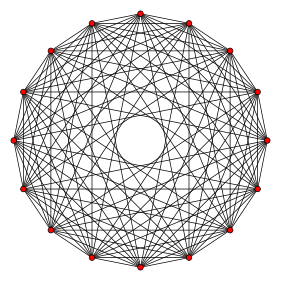 Orthogonal projection inside Petrie polygon | |
| Type | Regular 8-polytope |
| Family | orthoplex |
| Schläfli symbol | {3,4} {3,3,3,3,3,3} |
| Coxeter-Dynkin diagrams | |
| 7-faces | 256 {3} |
| 6-faces | 1024 {3} |
| 5-faces | 1792 {3} |
| 4-faces | 1792 {3} |
| Cells | 1120 {3,3} |
| Faces | 448 {3} |
| Edges | 112 |
| Vertices | 16 |
| Vertex figure | 7-orthoplex |
| Petrie polygon | hexadecagon |
| Coxeter groups | C8, D8, |
| Dual | 8-cube |
| Properties | convex, Hanner polytope |
In geometry, an 8-orthoplex or 8-cross polytope is a regular 8-polytope with 16 vertices, 112 edges, 448 triangle faces, 1120 tetrahedron cells, 1792 5-cells 4-faces, 1792 5-faces, 1024 6-faces, and 256 7-faces.
It has two constructive forms, the first being regular with Schläfli symbol {3,4}, and the second with alternately labeled (checkerboarded) facets, with Schläfli symbol {3,3,3,3,3,3} or Coxeter symbol 511.
It is a part of an infinite family of polytopes, called cross-polytopes or orthoplexes. The dual polytope is an 8-hypercube, or octeract.
Alternate names
- Octacross, derived from combining the family name cross polytope with oct for eight (dimensions) in Greek
- Diacosipentacontahexazetton as a 256-facetted 8-polytope (polyzetton)
As a configuration
This configuration matrix represents the 8-orthoplex. The rows and columns correspond to vertices, edges, faces, cells, 4-faces, 5-faces, 6-faces and 7-faces. The diagonal numbers say how many of each element occur in the whole 8-orthoplex. The nondiagonal numbers say how many of the column's element occur in or at the row's element.
The diagonal f-vector numbers are derived through the Wythoff construction, dividing the full group order of a subgroup order by removing individual mirrors.
| B8 | k-face | fk | f0 | f1 | f2 | f3 | f4 | f5 | f6 | f7 | k-figure | notes | |
|---|---|---|---|---|---|---|---|---|---|---|---|---|---|
| B7 | ( ) | f0 | 16 | 14 | 84 | 280 | 560 | 672 | 448 | 128 | {3,3,3,3,3,4} | B8/B7 = 2^8*8!/2^7/7! = 16 | |
| A1B6 | { } | f1 | 2 | 112 | 12 | 60 | 160 | 240 | 192 | 64 | {3,3,3,3,4} | B8/A1B6 = 2^8*8!/2/2^6/6! = 112 | |
| A2B5 | {3} | f2 | 3 | 3 | 448 | 10 | 40 | 80 | 80 | 32 | {3,3,3,4} | B8/A2B5 = 2^8*8!/3!/2^5/5! = 448 | |
| A3B4 | {3,3} | f3 | 4 | 6 | 4 | 1120 | 8 | 24 | 32 | 16 | {3,3,4} | B8/A3B4 = 2^8*8!/4!/2^4/4! = 1120 | |
| A4B3 | {3,3,3} | f4 | 5 | 10 | 10 | 5 | 1792 | 6 | 12 | 8 | {3,4} | B8/A4B3 = 2^8*8!/5!/8/3! = 1792 | |
| A5B2 | {3,3,3,3} | f5 | 6 | 15 | 20 | 15 | 6 | 1792 | 4 | 4 | {4} | B8/A5B2 = 2^8*8!/6!/4/2 = 1792 | |
| A6A1 | {3,3,3,3,3} | f6 | 7 | 21 | 35 | 35 | 21 | 7 | 1024 | 2 | { } | B8/A6A1 = 2^8*8!/7!/2 = 1024 | |
| A7 | {3,3,3,3,3,3} | f7 | 8 | 28 | 56 | 70 | 56 | 28 | 8 | 256 | ( ) | B8/A7 = 2^8*8!/8! = 256 |
Construction
There are two Coxeter groups associated with the 8-cube, one regular, dual of the octeract with the C8 or symmetry group, and a half symmetry with two copies of 7-simplex facets, alternating, with the D8 or symmetry group. A lowest symmetry construction is based on a dual of an 8-orthotope, called an 8-fusil.
| Name | Coxeter diagram | Schläfli symbol | Symmetry | Order | Vertex figure |
|---|---|---|---|---|---|
| regular 8-orthoplex | {3,3,3,3,3,3,4} | 10321920 | |||
| Quasiregular 8-orthoplex | {3,3,3,3,3,3} | 5160960 | |||
| 8-fusil | 8{} | 256 |
Cartesian coordinates
Cartesian coordinates for the vertices of an 8-cube, centered at the origin are
- (±1,0,0,0,0,0,0,0), (0,±1,0,0,0,0,0,0), (0,0,±1,0,0,0,0,0), (0,0,0,±1,0,0,0,0),
- (0,0,0,0,±1,0,0,0), (0,0,0,0,0,±1,0,0), (0,0,0,0,0,0,0,±1), (0,0,0,0,0,0,0,±1)
Every vertex pair is connected by an edge, except opposites.
Images
| B8 | B7 | ||||
|---|---|---|---|---|---|

|
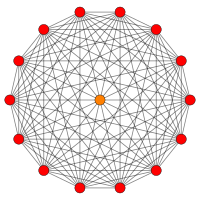
| ||||
| B6 | B5 | ||||

|
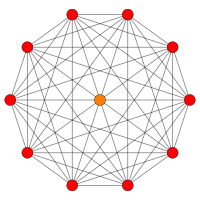
| ||||
| B4 | B3 | B2 | |||

|
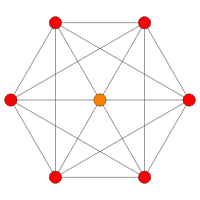
|
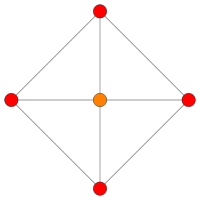
| |||
| A7 | A5 | A3 | |||

|

|

| |||
It is used in its alternated form 511 with the 8-simplex to form the 521 honeycomb.
References
- Coxeter, Regular Polytopes, sec 1.8 Configurations
- Coxeter, Complex Regular Polytopes, p.117
- Klitzing, Richard. "x3o3o3o3o3o3o4o - ek".
- H.S.M. Coxeter:
- H.S.M. Coxeter, Regular Polytopes, 3rd Edition, Dover New York, 1973
- Kaleidoscopes: Selected Writings of H.S.M. Coxeter, edited by F. Arthur Sherk, Peter McMullen, Anthony C. Thompson, Asia Ivic Weiss, Wiley-Interscience Publication, 1995, ISBN 978-0-471-01003-6
- (Paper 22) H.S.M. Coxeter, Regular and Semi Regular Polytopes I,
- (Paper 23) H.S.M. Coxeter, Regular and Semi-Regular Polytopes II,
- (Paper 24) H.S.M. Coxeter, Regular and Semi-Regular Polytopes III,
- Norman Johnson Uniform Polytopes, Manuscript (1991)
- N.W. Johnson: The Theory of Uniform Polytopes and Honeycombs, Ph.D.
- Klitzing, Richard. "8D uniform polytopes (polyzetta) x3o3o3o3o3o3o4o - ek".
External links
- Olshevsky, George. "Cross polytope". Glossary for Hyperspace. Archived from the original on 4 February 2007.
- Polytopes of Various Dimensions
- Multi-dimensional Glossary
| Fundamental convex regular and uniform polytopes in dimensions 2–10 | ||||||||||||
|---|---|---|---|---|---|---|---|---|---|---|---|---|
| Family | An | Bn | I2(p) / Dn | E6 / E7 / E8 / F4 / G2 | Hn | |||||||
| Regular polygon | Triangle | Square | p-gon | Hexagon | Pentagon | |||||||
| Uniform polyhedron | Tetrahedron | Octahedron • Cube | Demicube | Dodecahedron • Icosahedron | ||||||||
| Uniform polychoron | Pentachoron | 16-cell • Tesseract | Demitesseract | 24-cell | 120-cell • 600-cell | |||||||
| Uniform 5-polytope | 5-simplex | 5-orthoplex • 5-cube | 5-demicube | |||||||||
| Uniform 6-polytope | 6-simplex | 6-orthoplex • 6-cube | 6-demicube | 122 • 221 | ||||||||
| Uniform 7-polytope | 7-simplex | 7-orthoplex • 7-cube | 7-demicube | 132 • 231 • 321 | ||||||||
| Uniform 8-polytope | 8-simplex | 8-orthoplex • 8-cube | 8-demicube | 142 • 241 • 421 | ||||||||
| Uniform 9-polytope | 9-simplex | 9-orthoplex • 9-cube | 9-demicube | |||||||||
| Uniform 10-polytope | 10-simplex | 10-orthoplex • 10-cube | 10-demicube | |||||||||
| Uniform n-polytope | n-simplex | n-orthoplex • n-cube | n-demicube | 1k2 • 2k1 • k21 | n-pentagonal polytope | |||||||
| Topics: Polytope families • Regular polytope • List of regular polytopes and compounds | ||||||||||||
